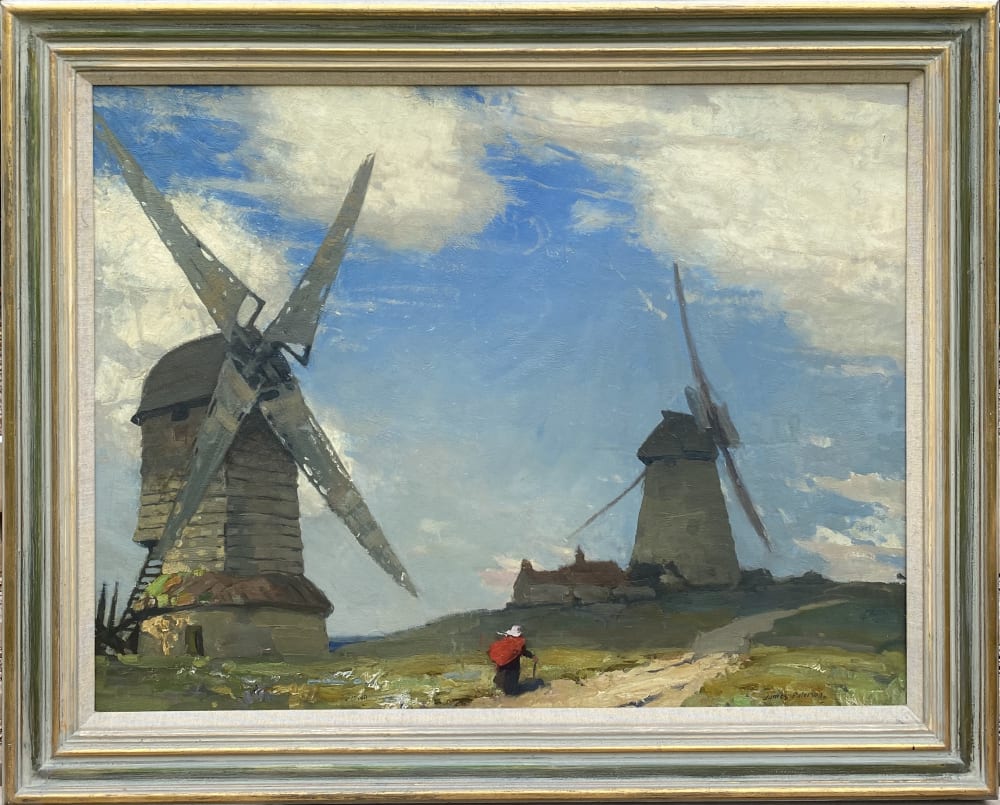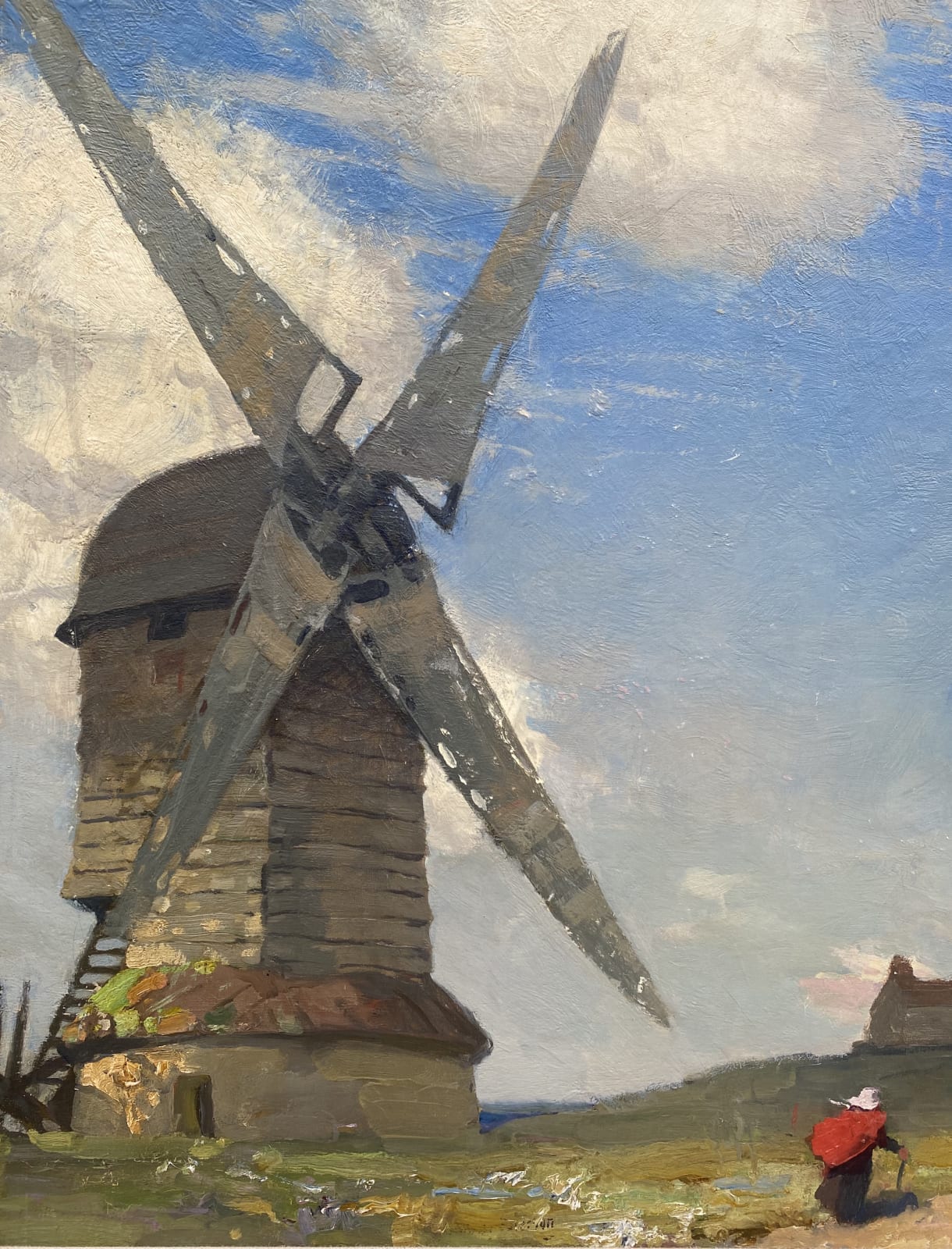James Paterson PRSW RSA RWS Scottish, 1854-1932
Jack and Jill, 1911
Oil
Size without frame 27 x 35 1/4 ins
Size with frame 34 1/2 x 42 1/2 ins
Size with frame 34 1/2 x 42 1/2 ins
Further images
Visualise On Your Wall
Born Hillhead, Glasgow, 21 August; died Edinburgh. Landscape painter, mainly in watercolour. After a short spell at the Western Academy, where he first met W Y MacGregor starting a lifelong friendship, later attended Glasgow Academy. An intention toward painting showed itself early but his father insisted on his son first going to university. After a year at university Paterson entered the business, also attending the local art school with landscape lessons from AD Robertson. Exhibited at the RSA (2) in 1874, a year later exhibited for the first time at the Glasgow Institute. Reassured by these signs of talent, his father eventually agreed to the young man abandoning business so in 1877, at the age of 23, Paterson went to Paris to continue art studies under Jacquesson de la Chevreuse. Subsequently joined the atelier of Jean Paul Laurens. Whilst in Paris Paterson paid short visits to Switzerland, Italy and Egypt, but long summer vacations were spent in Scotland and in the summer of 1878 he and W Y MacGregor painted at St Andrews.
Returning to Glasgow in the spring of 1882 he became associated with the group of slightly younger men then gathering under a banner of artistic revolt..
'Most of them - Guthrie, Crawhall and Henry at least - had been self-taught, and painting the country together they had been cultivating a broad and powerful manner of painting, which would represent the weight and mass of things and secure the unity and fullness of tone which had been neglected by most Scottish artists in favour of the more elaborate and less closely related rendering of nature. Paterson joined this coterie and, with his more informed command of values acquired in Paris, did finished studies while the others were still struggling over technical difficulties .. after marriage in 1884 to Eliza Ferguson, the couple settled in Moniaive in Dumfriesshire .. perhaps of all the French romanticists Corot was the painter whose work he appreciated most .. these things, however, were contributory to the expression of Paterson's personal sentiment for nature. Informed by true if not special feeling, good and occasionally quite beautiful in colour and taste, and designed on lines in which decoration and realism were happily blended, the pastorals he painted there possess an idyllic quality of their own .. his affection for the district of Moniaive and the spirit in which he painted it appear in the letterpress as well as in the illustrations of his monogram title Nithsdale, 1893 [Caw].
Paterson loved the harmonies of blues and browns and although sometimes a little vague was generally a fine watercolourist. He was a founder member of the Edinburgh Society of Eight in 1912, having moved to the capital seven years previously. Was appointed Librarian and then Secretary of the RSA. After losing his wife in 1910 he spent increasing time on the continent , especially Tenerife. The Mediterranean sun was echoed in a brighter palette. After 1898, although continuing to return to Moniaive, Edinburgh became the immediate source of his inspiration. The late development of his art was now taking place, with a stronger preference for picturesqueness of subject and a more decorative ensemble and a wider range of colour. Also painted portraits especially after 1900. Co-founded the Scottish Art Revue, and received a gold medal at the Munich International 1885. In 1890 he had been among those chosen to hang at the GI exhibition and was responsible for what became known in the City as the Impressionist room. This attracted exhibits from Steer, Clausen and others and although arousing bitter controversy at the time it can now be seen as an achievement of distinction and quality.
Elected ARSA 1896, RSA 1910, RSW 1885, President RSW 1916, RWS 1898. Exhibited RA (29), RSA (177), RWS (193), RSW (152), RHA (2), GI (130), AAS (1885-1931) and L (57). Represented in NGS, SNPG, Glasgow AG, Lillie AG (Milngavie), City of Edinburgh collection, Manchester AG, Abbot Hall AG (Kendal), Nat Gall of New Zealand (Wellington).
This painting was exhibited at the RSA in 1911, #151, titled Sussex Windmills.
The Clayton Sussex windmills are known locally as Jack and Jill and have featured in a number of films and television shows. They stand atop the South Downs, about seven miles north of Brighton. They have been through various refurbishments, but Jack and Jill were originally built, respectively, in 1866 and 1821, with the first windmill on site being built in 1765. Henry Longhurst lived in Jack for some time and indeed he devoted a full chapter to their history in his book of reminiscences: My Life and Soft Times, 1971, pp309-330.
Born Hillhead, Glasgow, 21 August; died Edinburgh. Landscape painter, mainly in watercolour. After a short spell at the Western Academy, where he first met W Y MacGregor starting a lifelong friendship, later attended Glasgow Academy. An intention toward painting showed itself early but his father insisted on his son first going to university. After a year at university Paterson entered the business, also attending the local art school with landscape lessons from AD Robertson. Exhibited at the RSA (2) in 1874, a year later exhibited for the first time at the Glasgow Institute. Reassured by these signs of talent, his father eventually agreed to the young man abandoning business so in 1877, at the age of 23, Paterson went to Paris to continue art studies under Jacquesson de la Chevreuse. Subsequently joined the atelier of Jean Paul Laurens. Whilst in Paris Paterson paid short visits to Switzerland, Italy and Egypt, but long summer vacations were spent in Scotland and in the summer of 1878 he and W Y MacGregor painted at St Andrews.
Returning to Glasgow in the spring of 1882 he became associated with the group of slightly younger men then gathering under a banner of artistic revolt..
'Most of them - Guthrie, Crawhall and Henry at least - had been self-taught, and painting the country together they had been cultivating a broad and powerful manner of painting, which would represent the weight and mass of things and secure the unity and fullness of tone which had been neglected by most Scottish artists in favour of the more elaborate and less closely related rendering of nature. Paterson joined this coterie and, with his more informed command of values acquired in Paris, did finished studies while the others were still struggling over technical difficulties .. after marriage in 1884 to Eliza Ferguson, the couple settled in Moniaive in Dumfriesshire .. perhaps of all the French romanticists Corot was the painter whose work he appreciated most .. these things, however, were contributory to the expression of Paterson's personal sentiment for nature. Informed by true if not special feeling, good and occasionally quite beautiful in colour and taste, and designed on lines in which decoration and realism were happily blended, the pastorals he painted there possess an idyllic quality of their own .. his affection for the district of Moniaive and the spirit in which he painted it appear in the letterpress as well as in the illustrations of his monogram title Nithsdale, 1893 [Caw].
Paterson loved the harmonies of blues and browns and although sometimes a little vague was generally a fine watercolourist. He was a founder member of the Edinburgh Society of Eight in 1912, having moved to the capital seven years previously. Was appointed Librarian and then Secretary of the RSA. After losing his wife in 1910 he spent increasing time on the continent , especially Tenerife. The Mediterranean sun was echoed in a brighter palette. After 1898, although continuing to return to Moniaive, Edinburgh became the immediate source of his inspiration. The late development of his art was now taking place, with a stronger preference for picturesqueness of subject and a more decorative ensemble and a wider range of colour. Also painted portraits especially after 1900. Co-founded the Scottish Art Revue, and received a gold medal at the Munich International 1885. In 1890 he had been among those chosen to hang at the GI exhibition and was responsible for what became known in the City as the Impressionist room. This attracted exhibits from Steer, Clausen and others and although arousing bitter controversy at the time it can now be seen as an achievement of distinction and quality.
Elected ARSA 1896, RSA 1910, RSW 1885, President RSW 1916, RWS 1898. Exhibited RA (29), RSA (177), RWS (193), RSW (152), RHA (2), GI (130), AAS (1885-1931) and L (57). Represented in NGS, SNPG, Glasgow AG, Lillie AG (Milngavie), City of Edinburgh collection, Manchester AG, Abbot Hall AG (Kendal), Nat Gall of New Zealand (Wellington).
This painting was exhibited at the RSA in 1911, #151, titled Sussex Windmills.
The Clayton Sussex windmills are known locally as Jack and Jill and have featured in a number of films and television shows. They stand atop the South Downs, about seven miles north of Brighton. They have been through various refurbishments, but Jack and Jill were originally built, respectively, in 1866 and 1821, with the first windmill on site being built in 1765. Henry Longhurst lived in Jack for some time and indeed he devoted a full chapter to their history in his book of reminiscences: My Life and Soft Times, 1971, pp309-330.
Join our mailing list
McEwan Gallery Newsletter
* denotes required fields
We will process the personal data you have supplied in accordance with our privacy policy (available on request). You can unsubscribe or change your preferences at any time by clicking the link in our emails.














